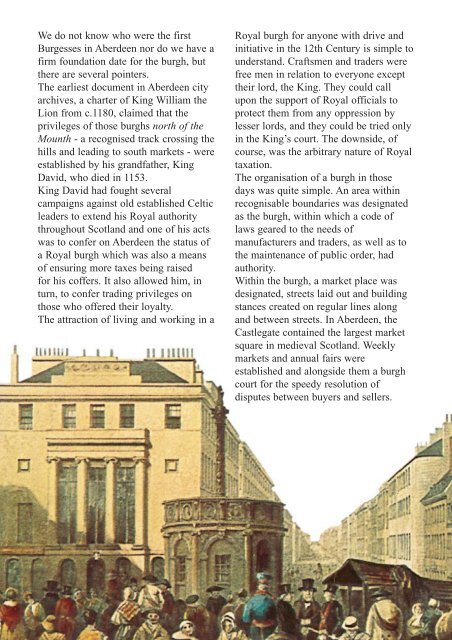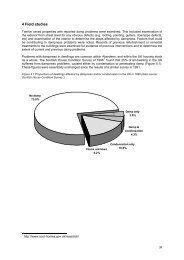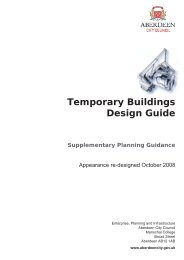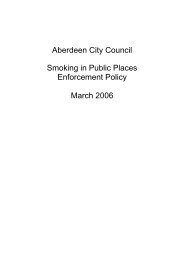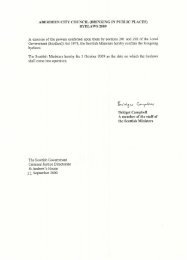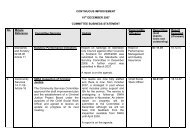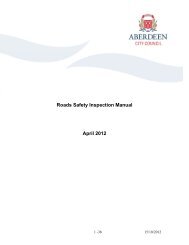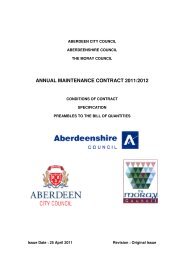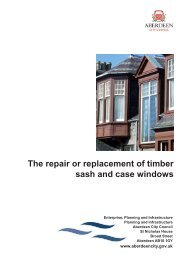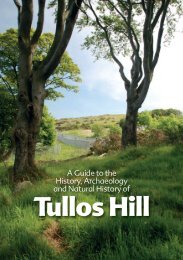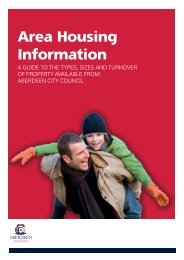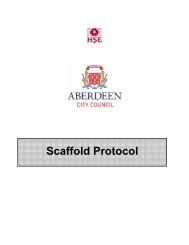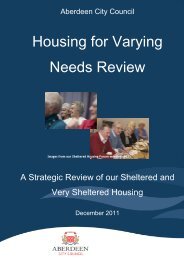he concept of the Burgess oath belongs - Aberdeen City Council
he concept of the Burgess oath belongs - Aberdeen City Council
he concept of the Burgess oath belongs - Aberdeen City Council
- No tags were found...
Create successful ePaper yourself
Turn your PDF publications into a flip-book with our unique Google optimized e-Paper software.
We do not know who were t<strong>he</strong> first<strong>Burgess</strong>es in <strong>Aberdeen</strong> nor do we have afirm foundation date for t<strong>he</strong> burgh, butt<strong>he</strong>re are several pointers.T<strong>he</strong> earliest document in <strong>Aberdeen</strong> cityarchives, a charter <strong>of</strong> King William t<strong>he</strong>Lion from c.1180, claimed that t<strong>he</strong>privileges <strong>of</strong> those burghs north <strong>of</strong> t<strong>he</strong>Mounth - a recognised track crossing t<strong>he</strong>hills and leading to south markets - wereestablis<strong>he</strong>d by his grandfat<strong>he</strong>r, KingDavid, who died in 1153.King David had fought severalcampaigns against old establis<strong>he</strong>d Celticleaders to extend his Royal authoritythroughout Scotland and one <strong>of</strong> his actswas to confer on <strong>Aberdeen</strong> t<strong>he</strong> status <strong>of</strong>a Royal burgh which was also a means<strong>of</strong> ensuring more taxes being raisedfor his c<strong>of</strong>fers. It also allowed him, inturn, to confer trading privileges onthose who <strong>of</strong>fered t<strong>he</strong>ir loyalty.T<strong>he</strong> attraction <strong>of</strong> living and working in aRoyal burgh for anyone with drive andinitiative in t<strong>he</strong> 12th Century is simple tounderstand. Craftsmen and traders werefree men in relation to everyone exceptt<strong>he</strong>ir lord, t<strong>he</strong> King. T<strong>he</strong>y could callupon t<strong>he</strong> support <strong>of</strong> Royal <strong>of</strong>ficials toprotect t<strong>he</strong>m from any oppression bylesser lords, and t<strong>he</strong>y could be tried onlyin t<strong>he</strong> King’s court. T<strong>he</strong> downside, <strong>of</strong>course, was t<strong>he</strong> arbitrary nature <strong>of</strong> Royaltaxation.T<strong>he</strong> organisation <strong>of</strong> a burgh in thosedays was quite simple. An area withinrecognisable boundaries was designatedas t<strong>he</strong> burgh, within which a code <strong>of</strong>laws geared to t<strong>he</strong> needs <strong>of</strong>manufacturers and traders, as well as tot<strong>he</strong> maintenance <strong>of</strong> public order, hadauthority.Within t<strong>he</strong> burgh, a market place wasdesignated, streets laid out and buildingstances created on regular lines alongand between streets. In <strong>Aberdeen</strong>, t<strong>he</strong>Castlegate contained t<strong>he</strong> largest marketsquare in medieval Scotland. Weeklymarkets and annual fairs wereestablis<strong>he</strong>d and alongside t<strong>he</strong>m a burghcourt for t<strong>he</strong> speedy resolution <strong>of</strong>disputes between buyers and sellers.


